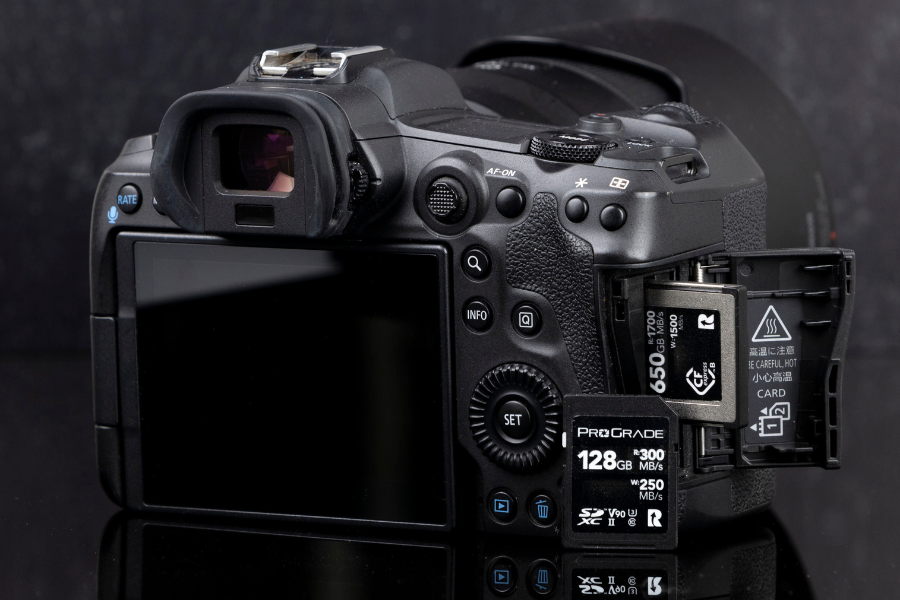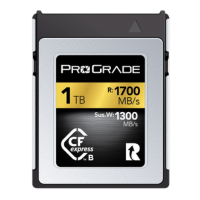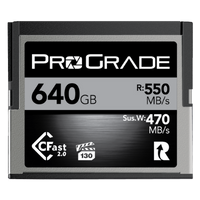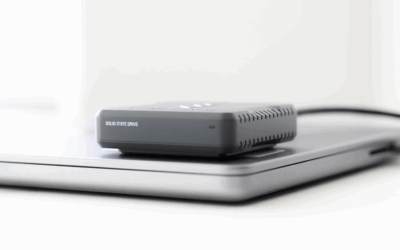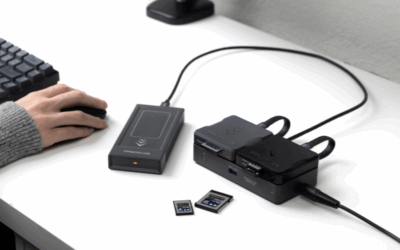As the landscape of professional photography and videography continues to evolve, the demand for more sophisticated and reliable equipment has never been higher. Among the myriad of advancements, the integration of dual card slots in cameras stands out as a game-changer for professionals in the field. This feature not only offers enhanced data management and security but also paves the way for uninterrupted shooting sessions, which is critical in capturing those once-in-a-lifetime moments.
Understanding the significance and the proper utilization of dual card slots, in tandem with selecting the right memory cards, can profoundly impact your workflow and the quality of your output. So, let’s delve into the advantages of dual card slots and how memory cards built specifically for professional photographers can help maximize the performance of your camera.
Understanding Dual Card Slots
Dual card slots in cameras represent a significant leap forward in photography and videography equipment design, offering you an array of advantages that cater to the demanding needs of professional shooting environments. This feature allows cameras to house two memory cards simultaneously, which can be used in various configurations depending on your needs. But what makes dual card slots so beneficial, and how do they contribute to data redundancy and workflow efficiency?
Advantages of Dual Card Slots
- Data Redundancy: One of the principal benefits of dual card slots is the ability to create real-time backups. Photographers and videographers can significantly mitigate the risk of data loss due to card failure by setting the camera to record the same data on both cards. This redundancy is essential during critical shooting scenarios, such as weddings or wildlife photography, where retaking a shot might be impossible.
- Increased Storage Capacity: Dual card slots effectively double the storage capacity available during a shoot, allowing for longer sessions without the need to switch out cards. This is especially beneficial for high-resolution formats like 4K or 8K video recording, which consume large amounts of data.
- Flexible File Management: You can configure dual card slots to separate file types—for instance, storing RAW images on one card and JPEGs on the other or videos on one and stills on the other. This separation simplifies the post-production process, making file management more efficient.
- Workflow Efficiency: For event photographers and videographers, the ability to switch cards without interrupting shooting is invaluable. When one card fills up, the camera can automatically switch to the second card, ensuring that no moment is missed. This seamless transition between cards can dramatically enhance workflow efficiency, reducing downtime and maximizing shooting potential.
Maximizing Dual Card Slot Benefits: Configuration and Settings
To fully leverage the advantages offered by dual card slots, understanding the various configuration options and settings is vital. These configurations can significantly impact your ability to manage data, ensure security, and maintain workflow efficiency. Here are some practical insights into maximizing the benefits of dual card slots through strategic configuration and settings.
- Backup Mode: This mode is critical for photographers who prioritize data security and cannot afford to lose any captured content. By setting the camera to backup mode, every photo or video recorded is simultaneously written to both cards. This instant redundancy ensures that even if one card fails, the data is safely stored on the other. It’s particularly useful in critical shooting scenarios, such as live events, where there’s no opportunity for a reshoot.
- Overflow Mode: For photographers focusing on maximizing storage, overflow mode allows the first card to be used until it’s full, at which point the camera automatically switches to the second card. This effectively doubles the shooting capacity without intervention, ideal for extended sessions or when shooting in high-resolution formats that quickly fill up storage space.
- Separate File Types: Another effective strategy is to use one card for RAW images and the other for JPEGs. This approach not only helps in managing and organizing files during post-processing but also ensures that if one type of file becomes corrupted, the other remains unaffected. Additionally, it allows photographers to quickly share one set of files (like JPEGs with smaller sizes) without having to sort through the data-heavy RAW files.
Advanced Configuration Tip
Some cameras offer the flexibility to customize the role of each card slot further. For instance, you can designate one card for photo storage and the other for video storage. Exploring these custom settings can enhance workflow efficiency, especially for hybrid shooters who frequently switch between stills and video.
By thoughtfully configuring your camera’s dual card slots and selecting the right settings, you can significantly enhance your shooting experience. Embracing these practices allows you to maximize the benefits of your camera’s capabilities, ensuring that you’re always ready to capture high-quality content, no matter the scenario.
Workflow Optimization: Streamlining Your Process with Dual Card Slots
Shooting with dual card slots inherently means generating twice as much data, especially when configured for redundancy or recording different file formats simultaneously. This surge in data volume underscores the necessity of streamlining your workflow to manage, organize, and back up your files efficiently.
It’s not just about managing your files effectively; it’s about enhancing the entire shooting-to-post-production pipeline to save time, improve reliability, and increase creative output.
When it comes to maximizing the efficiency of your photography workflow, especially with dual card slots, two often overlooked strategies stand out: smart storage management and leveraging workflow software. These practices can transform how you handle and process your images, saving you invaluable time and effort.
Smart Storage Management
Incorporating a disciplined approach to managing your memory cards can significantly simplify your post-production process. Here’s how you can implement effective storage management:
- Categorize your cards: Dedicate specific cards for different purposes—some for video, others for stills, and perhaps another set for backup. This organization ensures that you’re not only using your cards efficiently but also avoiding the confusion of mixed content types.
- Label your cards: Use labels or markers to clearly indicate the card’s designated use and its current status. Whether it’s “Video – Raw,” “Photos – JPEG,” or “Backup,” clear labeling helps you quickly grab the right card for the right task and avoid the costly mistake of using a card that’s already full, or worse, accidentally deleting its contents during a shoot. This simple yet effective practice ensures that your workflow remains uninterrupted and your data stays secure.
- Maintain a usage log: Keeping a log of which cards have been used in which shoots, including the content type and date, aids in tracking your storage workflow. This log can be invaluable in managing your archive, especially when dealing with multiple projects or when needing to retrieve specific files quickly.
Leveraging Workflow Software
Workflow software is a powerful tool that can automate and simplify the process of importing, backing up, and sorting your images. By harnessing the capabilities of such software, you can make your dual card slot setup even more efficient:
- Automated importing and sorting: Configure your workflow software to recognize the metadata from each card slot. You can set up automated tasks that import RAW files to one folder and JPEGs to another or even sort files based on other criteria like shooting date, camera used, or file type. This automation saves hours of manual sorting and ensures your files are organized from the moment they’re imported.
- Direct interface with memory cards: Choose software that can directly interface with your memory cards, allowing for immediate backup and file management as soon as the cards are connected to your computer. This direct interaction eliminates the need for manual file transfers and reduces the risk of data loss.
- Custom Backup Solutions: Utilize software features to create custom backup routines that suit your workflow. Whether it’s backing up RAW files to an external hard drive while sending JPEGs to a cloud service or keeping a mirrored backup of everything for extra security, workflow software can cater to your specific needs.
By embracing smart storage management and leveraging the right workflow software, you can make the dual card slots in your camera work harder for you. These strategies not only optimize your shooting and post-production workflow but also ensure that you can focus more on your creative process and less on the logistics of file management. With your memory cards neatly organized and your files automatically sorted and backed up, you’re well on your way to a more streamlined, efficient, and productive photography workflow.
ProGrade Digital Memory Cards: The Professional’s Choice for Dual Slot Cameras
Cameras with dual card slots introduce a level of flexibility and security that directly impacts your workflow efficiency. With the peace of mind that data redundancy provides, you can focus on creativity and composition rather than worrying about data integrity.
But this advantage is fully realized only when paired with capable memory cards. Consumer-grade cards might fall short in the demanding environments of professional photography, often lacking the speed, durability, and reliability needed for seamless data handling. This is where the essence of ProGrade Digital memory cards comes into play, transforming potential into performance.
Engineered to meet the exacting standards of high-stakes photography and videography, all ProGrade memory cards are designed to complement the dual card slot feature of modern cameras, enhancing both reliability and performance.
Here are three key advantages of selecting professional-grade memory cards designed specifically for photography:
1. Superior Read Speed = Enhanced Data Management
Using dual card slots naturally results in handling a larger volume of data. Professional-grade memory cards are designed to transfer this data swiftly, minimizing the time spent waiting for transfers to complete, which is especially significant when working with large RAW files or high-resolution videos.
Imagine the dual card slots as two lanes on a high-speed highway; the flow is only as good as the capacity and speed of the lanes themselves. ProGrade Digital memory cards act as the express lanes, adept at managing the increased volume of data, ensuring that the transfer of your creative work from camera to storage or post-production is swift and seamless. The alternative? Getting stuck in traffic, watching the progress bar slowly inch forward.
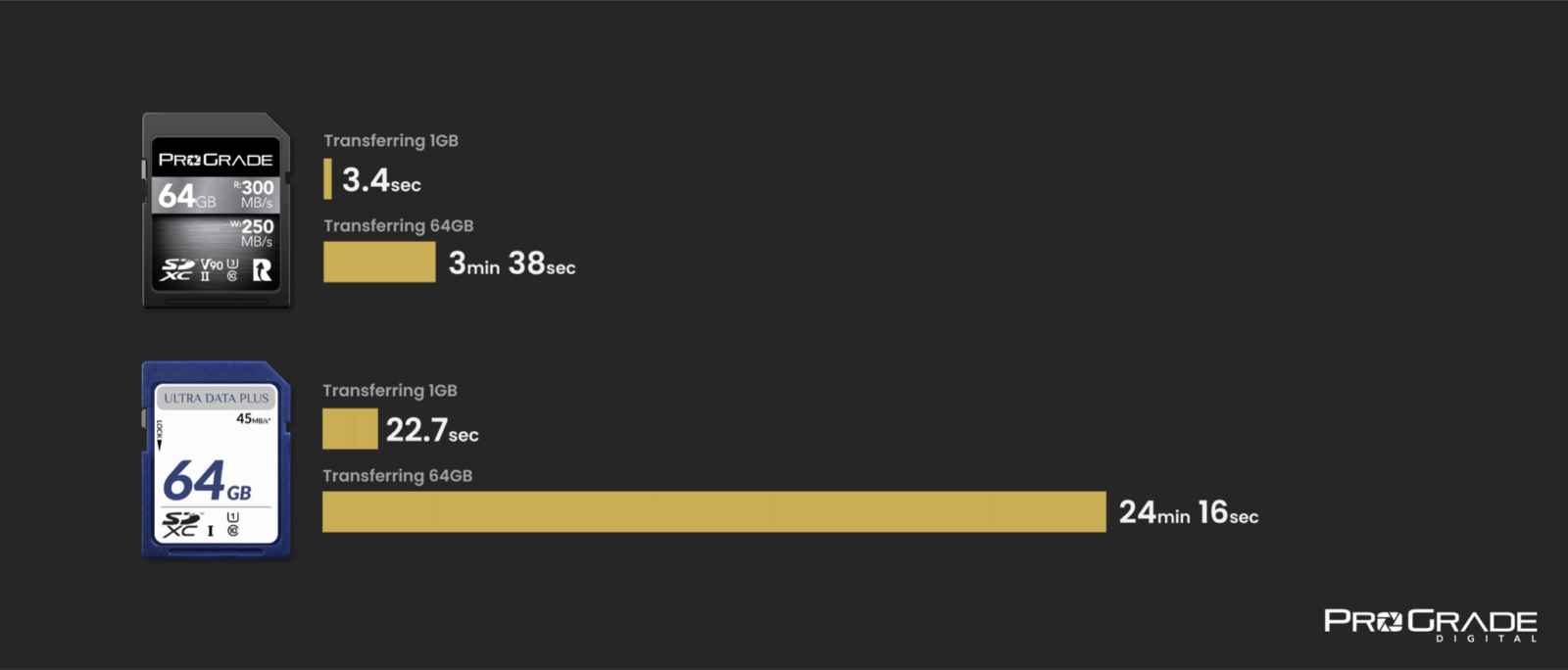
For example, as seen on the image above, while a consumer-grade SDXC card with a read speed of 45MB/s takes almost half an hour to transfer the entire card (64GB of data) to your computer, then a ProGrade Digital SDXC V90 memory card with a read speed of 300MB/s gets the exact same job done in three and a half minutes. When you’re working with multiple cards back-to-back, the time savings add up quickly, potentially saving you hours. This efficiency not only speeds up your post-shoot workflow but also gets you back to doing what you love sooner.
2. Ultra-Fast Write Speed = Seamless Shooting Experience
The write speed of a memory card is equally important, if not more. It not only influences the efficiency with which images and videos are saved but also plays a pivotal role in the overall performance of your camera. Slower cards can significantly hinder your camera’s ability to function at its best, particularly in modes that require rapid data processing, such as continuous shooting or high-resolution video recording. Certain advanced shooting modes and capabilities, like capturing 4K or 8K videos, high-speed burst photos, or raw image sequences, are only fully accessible with cards that can match the camera’s data throughput demands.
The following chart clearly illustrates how some shooting modes on a Sony Alpha 7S III camera are only available when using a memory card with fast write speeds, such as ProGrade Digital SDXC V60 or ProGrade Digital SDXC V90 memory card.
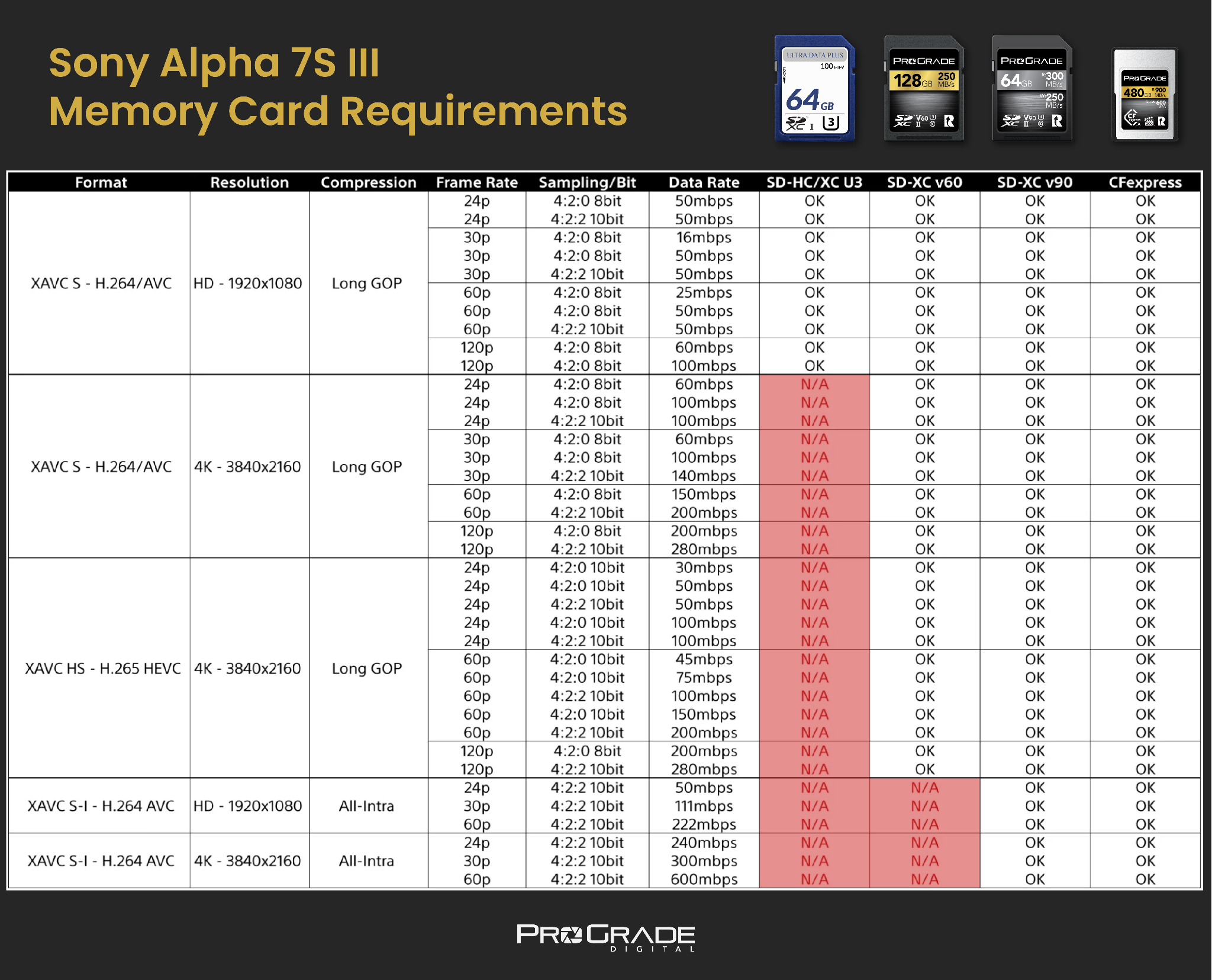
Using a card with insufficient write speed may result in frustrating delays, missed shots, or even the inability to select these high-performance modes. Therefore, selecting memory cards with optimal write speeds is critical, not just for ensuring smooth operation but also for unlocking the full suite of features your camera offers, enabling you to capture your creative vision without compromise.
3. Premium Build Quality = Outstanding Data Safety
ProGrade Digital Memory Cards are engineered to endure the rigors of professional use. Designed to perform in harsh conditions, these cards can withstand temperatures ranging from -10°C to 70°C, making them perfect companions for shoots in challenging environments like snowy landscapes and deserts. They are also dust, water, X-ray, and shockproof, with a built-in write protect switch to prevent accidental data loss.
On top of all that reliability, ProGrade Digital memory cards are also Refresh Pro compatible. It is a unique maintenance software designed by ProGrade to keep your memory cards in peak condition. Refresh Pro assesses the card’s health, offering insights into its condition and alerting you when a card needs attention. Beyond regular health checks, its standout feature is the ability to sanitize your memory card, effectively resetting it to a factory-new state. This process does more than just minimize the risk of data corruption—it rejuvenates your card, extending its lifespan and ensuring you get more out of it.

Yet, if the unforeseen should still happen, Recovery Pro software provides a critical safety net. This tool is specifically created to recover a wide range of file types, including both common and complex video and photo files. Recovery Pro is a reliable solution for retrieving valuable work, from accidental deletions to corrupt files.
Selecting the Ideal Memory Cards for Your Dual Slot Camera: A Guide
When selecting memory cards for dual-slot cameras, navigating through the myriad options can be simplified by focusing on three key considerations: compatibility, speed, and your specific usage pattern.
Here’s a guide to assist you in making an informed choice:
STEP1 – Compatibility
The first step is determining which memory card types your camera supports. Cameras vary widely in slot configurations, accommodating combinations like SDXC and SDXC, CFexpress and SDXC, CFast and SDXC, among others. Our compatibility charts and technical data sheets can be a handy reference to ensure you’re looking at the right type of cards for each slot in your camera.
STEP 2 – Speed
Once you’ve identified compatible card types, aim for the fastest card your camera asks for and budget allows. The reason is straightforward: a faster card ensures your camera operates at its peak capability, especially important for high-speed shooting or recording high-resolution video. Opting for the fastest available card helps avoid bottlenecks, keeping your workflow smooth and efficient.
STEP 3 – Consider Your Shooting Style and Usage
- Uniform Card Slots: If your camera supports the same type of card in both slots, prioritizing speed is simple—choose the fastest cards you can for both.
- Mixed Card Slots: For cameras with different types of slots, your approach should hinge on how you plan to use them.
-
- Simultaneous Recording to Both Slots: If you’re recording the same data to both cards for redundancy, the speed of the slower card will dictate your shooting speed. For example, there’s no benefit to using a faster CFexpress Type A memory card in one slot, as the maximum speed of the SDXC card in slot two dictates the overall speed limit. Similarly, the faster write speed of the SDXC V90 memory card will be limited if you use the SDXC V60 memory card in the second slot.
-
- Separate Functions for Each Slot: If you use one slot for video and the other for stills, or RAW files on one and JPEGs on the other, consider investing in a faster card for the slot handling the more demanding data (typically high-resolution video or RAW files). This ensures that you’re not limited by write speeds when capturing demanding formats.
-
- High-Speed Shooting Modes: For photographers who lean heavily into burst shooting or high-definition video, allocating a faster card to the primary slot used for these tasks can prevent buffer delays and maximize performance.
By thoughtfully considering these aspects—compatibility, speed, and how you plan to use the dual slots—you can tailor your memory card choices to fit your shooting style perfectly. Whether you’re juggling fast-paced sports photography, cinematic video projects, or anything in between, the right memory cards will keep your focus on creativity rather than capacity or speed constraints.
Conclusion: Elevating Your Photography with Dual Card Slots and ProGrade Memory Cards
And there you have it. Dual card slots revolutionize photography by offering unparalleled security and flexibility, ensuring you never miss a moment. ProGrade memory cards amplify this advantage, providing the speed and reliability needed to harness the full potential of your camera.
Now that you know how to maximize the potential of your dual-slot camera, it’s time to take action. Implement these insights into your photography toolkit and experience the seamless efficiency, unmatched reliability, and creative freedom they offer. With dual card slots and ProGrade by your side, there are no limits to what you can achieve.
